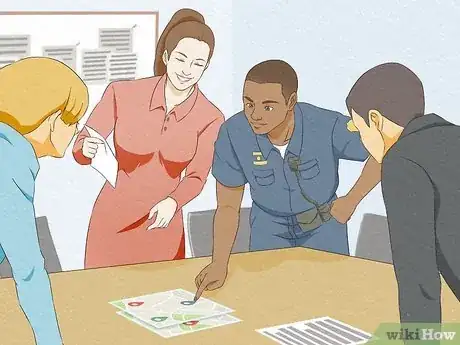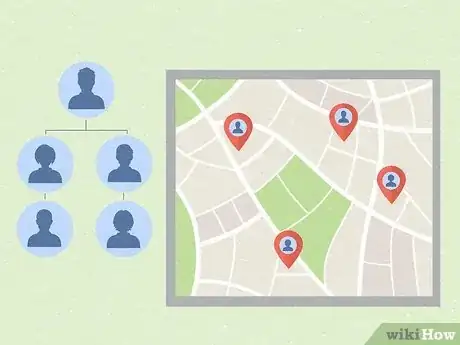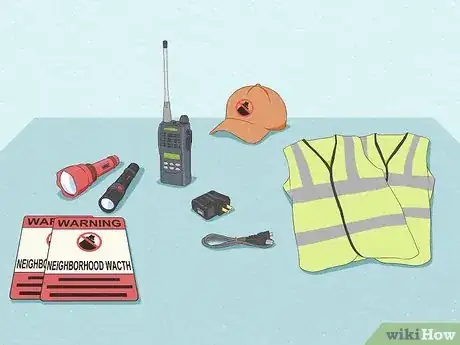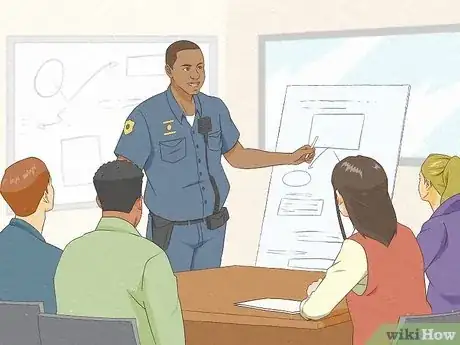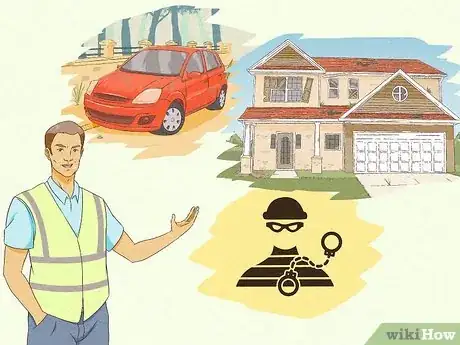This article was co-authored by Saul Jaeger, MS. Saul Jaeger is a Police Officer and Captain of the Mountain View, California Police Department (MVPD). Saul has over 17 years of experience as a patrol officer, field training officer, traffic officer, detective, hostage negotiator, and as the traffic unit’s sergeant and Public Information Officer for the MVPD. At the MVPD, in addition to commanding the Field Operations Division, Saul has also led the Communications Center (dispatch) and the Crisis Negotiation Team. He earned an MS in Emergency Services Management from the California State University, Long Beach in 2008 and a BS in Administration of Justice from the University of Phoenix in 2006. He also earned a Corporate Innovation LEAD Certificate from the Stanford University Graduate School of Business in 2018.
There are 10 references cited in this article, which can be found at the bottom of the page.
wikiHow marks an article as reader-approved once it receives enough positive feedback. In this case, 100% of readers who voted found the article helpful, earning it our reader-approved status.
This article has been viewed 58,288 times.
Organizing a neighborhood watch group can help prevent crime in your neighborhood through awareness and closer relationships among neighbors. In order to set up a Neighborhood Watch, you need interested neighbors who are willing to keep an eye out and alert others of suspicious and potentially dangerous activity. A successful Neighborhood Watch community requires time and dedication, as well as support from your neighbors and local law enforcement.
Steps
Gauging Interest for a Neighborhood Watch
-
1Ask neighbors if they’re interested in starting a Neighborhood Watch. If there have been recent crimes in your area, chances are interest is high. If not, enthusiasm might be low, but remind your friends and neighbors that the majority of crimes in the US are property crimes, and that a Neighborhood Watch is best-suited to combat property crimes.[1]
-
2Determine further interest via door-to-door campaigning. Gather information about recent crime in your area. Speak to other neighbors, inform them of the facts, and ask them about their interest in participating in a Neighborhood Watch. Distribute flyers inviting all neighbors to a Neighborhood Watch meeting at a central gathering point in your area.[2]
- Assure your neighbors that there are many ways of participating, from being a window watcher to being a block captain. Everyone can help!
- Ask new members if there are any additional crimes they want to address or feel particularly threatened by.
Advertisement -
3Reach out to local law enforcement. Any Neighborhood Watch, though managed and composed of your community members, will operate with the help and supervision of the police. The Sheriff’s Office should assign a Crime Prevention Officer to help train your members and determine if a different or increased Neighborhood Watch structure is necessary.[3] For a Neighborhood Watch to be successful, it is essential that local law enforcement and citizens understand each other.[4]
- You may be starting your Neighborhood Watch program because you are dissatisfied with local law enforcement, but keep in mind that oftentimes local law enforcement can be concerned with city- or even region-wide crimes. Remind your local law enforcement about your community’s needs, and ask them how they can help you.
Setting Up Your Neighborhood Watch
-
1Map out the area. Work with law enforcement to create an accurate map of the area. Map out all of the houses in your neighborhood, and then highlight houses that are interested in being involved. Make sure your Neighborhood Watch is large enough to deal with the crimes your neighborhood is concerned about.[5]
- Do not share your map with anyone outside your neighborhood!
- If you do not have enough interest, focus on gathering more members before continuing the process.
- Remember: the strength of a Neighborhood Watch lies in the number of eyes and ears that are working together!
-
2Establish your Neighborhood Watch coordinator. Traditional Neighborhood Watches have one coordinator, but if your neighborhood is large enough, you might want to consider appointing co-coordinators. Coordinators are in charge of communicating with local law enforcement and developing meaningful projects that are beneficial for the community at large.[6]
-
3Appoint Neighborhood Watch block captains. Each block should have at least one block captain. Block captain commitment is central to your Neighborhood Watch’s success, so look for members who are active in your community. Block captains are in charge of recruiting new members, updating the membership list, and participating in leadership meetings.[7]
-
4Hold a Neighborhood Watch meeting. Invite local law enforcement and all of your neighbors to a meeting to discuss how to start your Neighborhood Watch and what a Neighborhood Watch is. Introduce your coordinator and block captains. Specify what crimes you wish to address, and explain how the Neighborhood Watch will accomplish that. Collect and distribute everyone’s contact information.[8]
- Have local law enforcement answer questions about crime and provide information about police procedures.[9]
- Remind your volunteers that a Neighborhood Watch is not a vigilante group, and they should never put themselves in harm's way!
-
5Train phone tree volunteers. A Neighborhood Watch phone tree connects each citizen to two other citizens, and each of those citizens to two more citizens, etc. When any citizen sees a potential crime, they can activate the phone tree by calling their two phone numbers and pass the message quickly and efficiently along the phone tree chain.
- Download and print out phone tree templates on the Internet, and make sure you write down all relevant information including name, address, phone number, and email.
- Remind everyone of the importance of only passing on essential, actionable information during phone tree calls.
- In certain situations, like life-threatening crimes or the presence of particularly dangerous criminals, teach your volunteers to call the police before calling the phone tree.
- If you live in a particularly tech-savvy community, consider also setting up an email tree as an alternate method of passing on less pressing information.
Maintaining Your Neighborhood Watch
-
1Order a starter kit. Many cities have their own Neighborhood Watch materials, so check in with your Sheriff's Office to see if you can get materials from them. If not, order a free Neighborhood Watch starter kit from the National Sheriffs Association or from various other national Neighborhood Watch Organizations.
-
2Make sure your coordinator keeps in touch with law enforcement. Your local Sheriff’s Office should have assigned a Crime Prevention Officer to your Neighborhood Watch Unit. Have your coordinator meet with this officer on a regular basis, to ensure the officer is up to date on all crimes in the neighborhood.[12]
- If relevant, you can have your Crime Prevention Officer attend your regular Neighborhood Watch meetings, to brief the citizens on your neighborhood’s current crime situation.
-
3Schedule monthly leadership meetings. Make sure your coordinator(s) and block captains meet regularly to ensure everyone is on the same page. Go over concerns, evaluate current initiatives, and brainstorm new projects. When relevant, leadership meetings should also be a time where leadership officers can prepare for the general Neighborhood Watch meeting.
- If your Neighborhood Watch has decided that they don’t want your Crime Prevention Officer to attend general Neighborhood Watch meetings, consider inviting your Crime Prevention Officer to your leadership meetings.
-
4Hold quarterly general meetings. Keep your Neighborhood Watch group active by creating a social gathering place for neighbors to come together, discuss crime prevention strategies, and touch base with Neighborhood Watch leadership. Consider providing snacks and keeping the meeting times short.[13]
- Always end every Neighborhood Watch meeting with a reminder that your neighbors should never put themselves in harm’s way!
-
5Tackle new challenges as they arise. Over time, new challenges may rise up to replace your original security concerns. Remember, a Neighborhood Watch should be flexible in order to best address the community’s needs. Even new challenges don’t crop up, neighborhood improvement projects can help remove physical conditions, like abandoned cars or overgrown lots, that make it easier for crime to happen in the first place.
Expert Q&A
-
QuestionHow can I work with local police to make my neighborhood safer?
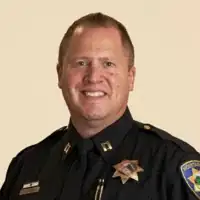 Saul Jaeger, MSSaul Jaeger is a Police Officer and Captain of the Mountain View, California Police Department (MVPD). Saul has over 17 years of experience as a patrol officer, field training officer, traffic officer, detective, hostage negotiator, and as the traffic unit’s sergeant and Public Information Officer for the MVPD. At the MVPD, in addition to commanding the Field Operations Division, Saul has also led the Communications Center (dispatch) and the Crisis Negotiation Team. He earned an MS in Emergency Services Management from the California State University, Long Beach in 2008 and a BS in Administration of Justice from the University of Phoenix in 2006. He also earned a Corporate Innovation LEAD Certificate from the Stanford University Graduate School of Business in 2018.
Saul Jaeger, MSSaul Jaeger is a Police Officer and Captain of the Mountain View, California Police Department (MVPD). Saul has over 17 years of experience as a patrol officer, field training officer, traffic officer, detective, hostage negotiator, and as the traffic unit’s sergeant and Public Information Officer for the MVPD. At the MVPD, in addition to commanding the Field Operations Division, Saul has also led the Communications Center (dispatch) and the Crisis Negotiation Team. He earned an MS in Emergency Services Management from the California State University, Long Beach in 2008 and a BS in Administration of Justice from the University of Phoenix in 2006. He also earned a Corporate Innovation LEAD Certificate from the Stanford University Graduate School of Business in 2018.
Police Captain, Mountain View Police Department There are a lot of different ways. One of the biggest is getting to know your police department. If the police department is already doing outreach events—coffee with a cop, national night out, etc—attend them and talk to the cops. Go introduce yourself, hang out, and maybe even go on a ride-along. Feel free to ask questions when you're with an officer, like "What do you think is the biggest issue right now in our neighborhood?” and “What are you doing to address it?” It's really all about communication.
There are a lot of different ways. One of the biggest is getting to know your police department. If the police department is already doing outreach events—coffee with a cop, national night out, etc—attend them and talk to the cops. Go introduce yourself, hang out, and maybe even go on a ride-along. Feel free to ask questions when you're with an officer, like "What do you think is the biggest issue right now in our neighborhood?” and “What are you doing to address it?” It's really all about communication. -
QuestionWhere can I get some signs telling of the program?
 R2_d2000Top AnswererYou can buy signs online. Simply search for "Neighborhood Watch sign" in your favorite search engine to find them.
R2_d2000Top AnswererYou can buy signs online. Simply search for "Neighborhood Watch sign" in your favorite search engine to find them. -
QuestionDo you have a list of things for residents to look for and how to proceed?
 Benjamin M.Top AnswererContact local police or other neighbourhood watch organizations to see if they have any training manuals or other materials for the issues specific to your area and how to respond to them.
Benjamin M.Top AnswererContact local police or other neighbourhood watch organizations to see if they have any training manuals or other materials for the issues specific to your area and how to respond to them.
Warnings
- It's important to remember that Neighborhood Watch groups are not vigilantes and should not act like police. As a member of the Neighborhood Watch, simply ask neighbors to be alert, observant, and caring. If you see suspicious activity or crimes, report immediately to the police.⧼thumbs_response⧽
References
- ↑ https://www.houselogic.com/finances-taxes/home-insurance/start-a-neighborhood-watch/
- ↑ https://www.houselogic.com/finances-taxes/home-insurance/start-a-neighborhood-watch/
- ↑ http://www.co.marion.or.us/PW/EmergencyManagement/CCC/Pages/NW.aspx
- ↑ https://www.nnw.org/about-neighborhood-watch
- ↑ http://www.chulavistaca.gov/home/showdocument?id=13976
- ↑ http://www.livingeov.com/wp-content/uploads/2013/04/Coordinator-Responsibilities-Rev0312.pdf
- ↑ http://www.harnettsheriff.com/downloads/Block%20Captain%20Duties%20Neighb%20watch2.pdf
- ↑ http://www.chulavistaca.gov/home/showdocument?id=13976
- ↑ https://harfordsheriff.org/get-involved/neighborhood-watch/



